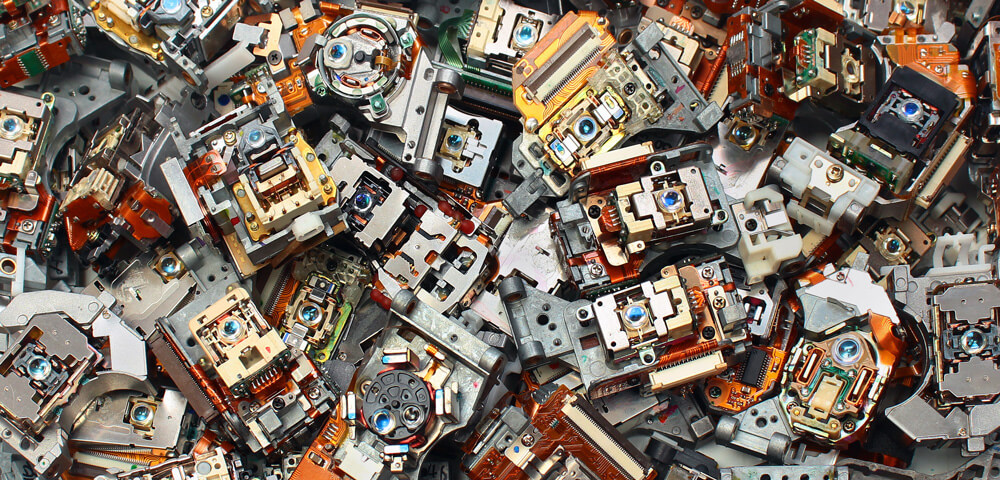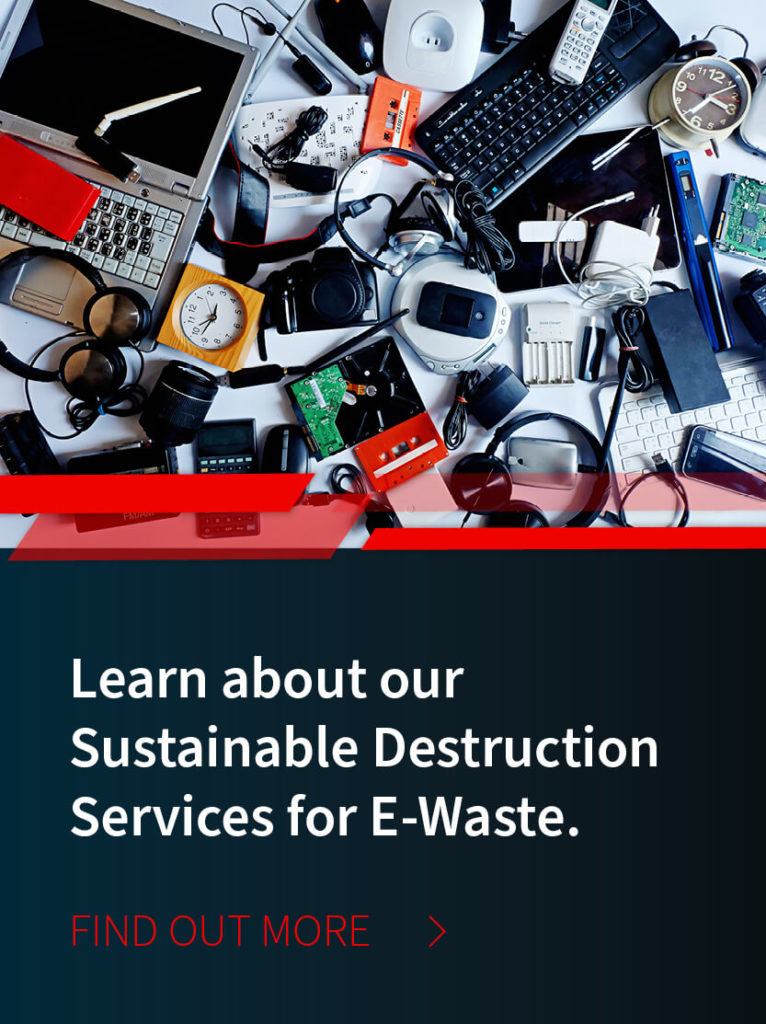
/ IN THIS BLOG
01 / The electronic waste explosion
The financial disruptions and operational challenges fostered by the recent chip shortage illustrated how ubiquitous electronics have become to business and industry. Look around your workplace. The odds are pretty much 100 percent that you have electronic waste that will someday require disposal.
You’re going to see:
Televisions
Computers and tablets—including screens, monitors, and hard drives
Electrical power packs, connecting cables, and AC cords
Cell Phones
Small appliances
Printers, scanners, and fax machines
CFL bulbs and florescent tubes
Telecommunication equipment—including servers, routers, and circuit boards
02 / Is “e-waste” a misnomer?
The common term for electronic waste—aka e-waste—is actually a misnomer per the EPA’s preferred nomenclature. This is because the agency wants you to think of such materials not as waste per se, but instead as “a subset of used electronics… that can be reused, refurbished, or recycled to minimize the actual waste that might end up in a landfill…”
So far, however, this distinction between vs. recyclables hasn't seized the public's imagination, at least when it comes to electronics. According to Earth911, the US generated 6.92 million tons of e-waste in 2019. That’s about 46 pounds per person, of which 85 percent was simply thrown away, winding up in landfills.
The potential upside here is that e-waste contains lots of recyclable materials, including lithium, gold, silver, and platinum. The cumulative value of these materials, per the same source, was $7.49 billion in 2019.
However, many e-waste constituents are significantly hazardous (usually toxic), such as mercury, lead, cadmium, polybrominated flame retardants, barium, and lithium—none of which should be buried in the ground, as they can leach into the groundwater or release hazardous gasses into the atmosphere as they decompose.
Yet, it’s estimated that 40 percent of the heavy metals in US landfills come from discarded electronics.
Are batteries considered e-waste?
Alkaline batteries—the kind you buy at the grocery to power your TV remote—are benign but should be considered universal waste.
Lithium-Ion batteries (Li-ion) are common in portable electronics (e.g., cell phones and laptops). They contain reactive chemicals that can ignite when packed closely with other metals (like in a garbage truck). Thus, they require universal waste management.
Nickel-metal hydride batteries (NiMH) are someplace in between. Typical in computer and medical equipment, they contain metals that can be hazardous.
Caution!
Remember that too much of anything can be considered a hazardous waste by the EPA. Don’t take chances.
If you routinely accrue large quantities of spent batteries, get expert advice before dumping them into that trash bin!
03 / State laws regarding e-waste
As of this writing, 25 states have laws that mandate e-waste recycling, and several others are developing legislation to do so. These laws typically use an “extended producer responsibility” (EPR) approach, which means the manufacturer of the electronic device must pay for its end-of-life recycling. But the initiative to get it to the recycler is still up to you.
04 / Ways to reduce e-waste
There are some common-sense ways by which you can lessen your e-waste and thereby reduce the cost and commitment for its universal waste management. Among them:
Choose your equipment manufacturers wisely. Try to buy electronics from sources that offer EPR end-of-life plans for what they sell, by which they’ll take defunct gear back and recycle it for you. Many companies and distributors position their end-of-life services as an added benefit, and they’re also incented to do so because it offers them a touchpoint for selling you needed replacements.
Buy high-quality products. Cheap electronics aren’t typically backed by tech support, EPR, or spare parts, making repairs nigh impossible. And as repair is almost always more cost-effective than replacement, cheap equipment winds up being more expensive over time, especially when you factor in disposal/recycling costs.
Donate or sell. Functioning or repairable equipment that can’t meet the growing needs of your enterprise can nonetheless be useful to other companies that don’t require as much computer memory, copying speed, monitor resolution, or whatever. If you can’t sell it, there are churches, organizations, and nonprofits who would be glad to have it. And you’ll save the disposal/recycling costs.
05 / The upshot
70 percent of the universal waste collected throughout the US consists of discarded electronic devices. This is not sustainable. As such, half of US states have already enacted legislation requiring the recycling of e-waste, with more to come.
If proper disposal of e-waste isn’t mandatory in your location now—it soon will be. Tossing old computers, televisions, copiers, etc. into the general waste stream will not be an option. And doing so will put you in the crosshairs of various federal, state, and local authorities.
06 / Get expert advice.
MCF Environmental Services is committed to making the recycling and disposal of e-waste easy, compliant, and sustainable for business and industry.
By taking a “partnering” approach with all industry sectors, organizations, and municipalities, we’re able to offer you unsurpassed expertise in categorization, parts recycling, data destruction, and waste disposal
We reduce your operational and compliance risks by managing every interaction of e-waste recycling—from collection to disposal.
Don’t know where to start? Contact one of our experts today. Or call 866.315.8116.
And thank you for reading our blog!
Robert Losurdo
President, COO








